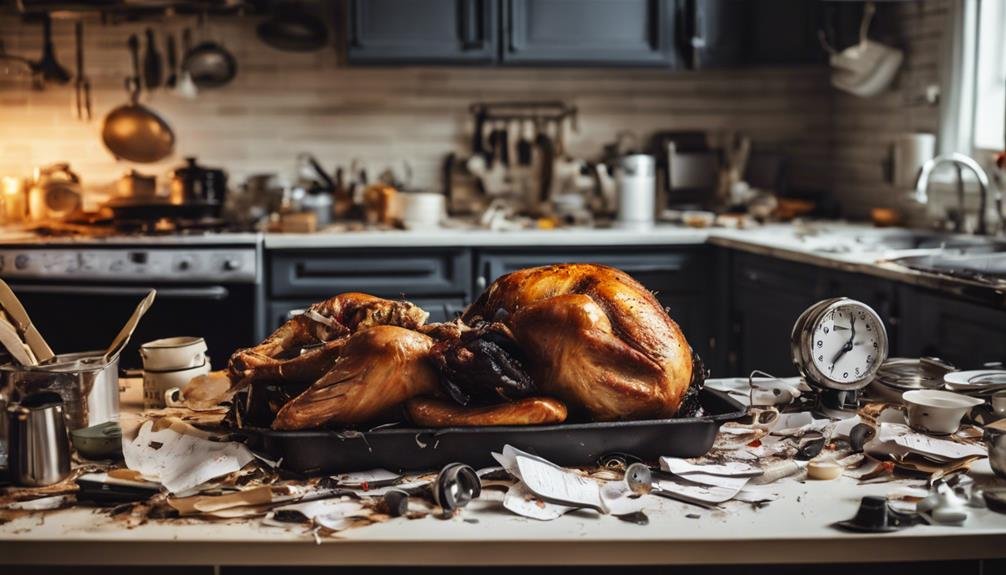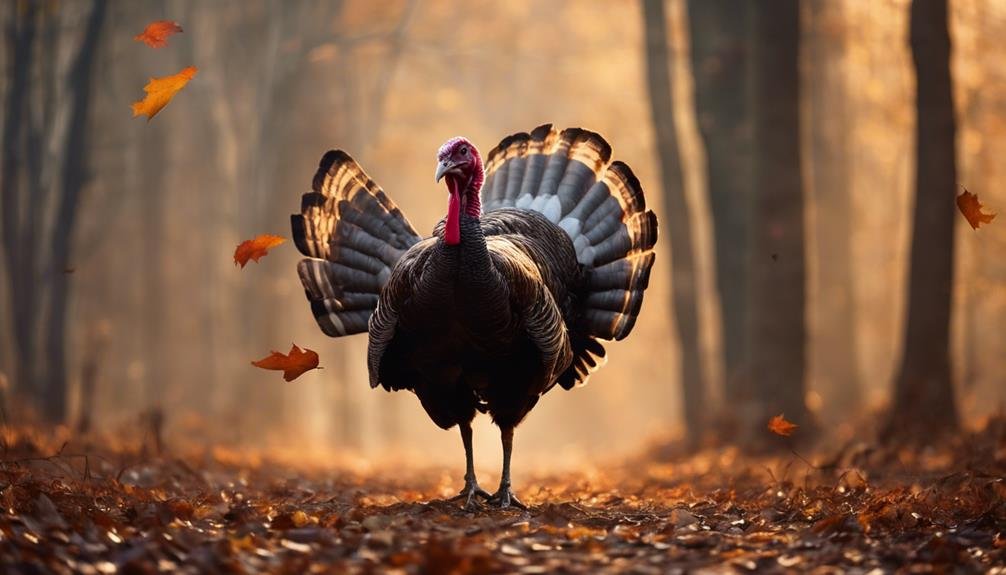Turkey timing blunders can make or break a hunt, and novice hunters often fall prey to dawn approaches, peak hour chaos, and overhunting a single location. These rookie mistakes can spook even the most gullible gobblers. Turkeys have an uncanny ability to recall locations and patterns, making silent approaches and adapting strategies vital to success. Avoid calling at dusk, and don't underestimate the power of mid-day hunting opportunities. The clock is ticking, and the difference between success and failure lies in the details. Brush up on the timing secrets the pros know, and you might just find yourself on the right side of the hunter's ledger.
Key Takeaways
- Avoid calling at dawn, as turkeys have elevated vantage points and are more alert during morning patrols.
- Refrain from calling at dusk, as turkeys have a vantage point from elevated perches, making them more vigilant.
- Hunt beyond dawn, as mid-morning and lunchtime can be productive periods for turkey hunting.
- Wait for turkeys to commit to calls, and be patient to increase chances of success.
- Mastering calling windows and timing strategies is vital to bagging a gobbler and avoiding failed hunts.
Don't Approach at Dawn
Don't fall into the trap of assuming dawn is the only time to hunt turkeys, because, let's face it, you're not the only one with this bright idea, and those birds are already on high alert. Turkeys have a vantage point from their elevated perches, allowing them to see potential threats, including humans. Approaching during dawn patrols can lead to failed hunts due to their elevated vantage points. Instead, consider a silent approach during morning shadows, when the sun is still low. A quiet entry is essential, as turkeys are more likely to be caught off guard. Avoid using lights, as they can spook the birds. By adapting your strategy, you can increase your chances of a successful hunt.
He Knows You're There
Turkeys have an uncanny ability to recall the locations where they've previously heard hen calls, and they'll often return to those same spots, making it essential to factor this into your hunting strategy. This remarkable turkey memory can be a blessing or a curse, depending on how you play it. If you're not careful, a gobbler might remember your previous attempts to lure him in, making him wary of your calls. A silent approach is vital in this scenario, as any sudden noise can spook your quarry. By taking the time to let the turkey commit, you increase your chances of success. Remember, patience is key, and a well-executed silent approach can be the difference between a successful hunt and a disappointing one.
Hunting During Peak Hours
Prime-time hunting hours, namely dawn and dusk, often receive disproportionate attention from hunters, but the reality is that these periods are not always the most productive. In fact, hunting during peak hours can be a recipe for disaster. The Peak Pressure during these times can lead to turkeys becoming hyper-vigilant, making them far more difficult to hunt. In addition, Prime Movement during these hours can be chaotic, making it challenging to pinpoint a gobbler's location. Instead of getting caught up in the hype surrounding these hours, hunters should focus on adapting to the turkey's behavior and adjusting their strategy accordingly. By doing so, they can increase their chances of success and avoid falling victim to the pitfalls of peak-hour hunting.
Mid-Day Hunting Opportunities
As the morning's fervor fades and the lunchtime lull sets in, many hunters mistakenly assume the turkey hunting action has slowed to a crawl, but in reality, this mid-day window can be a sneaky sweet spot for bagging a bird. Turkeys, now relaxed and less vigilant, may let their guard down, making them more susceptible to a well-executed siesta strategy. This is the perfect time to employ a stealthy approach, using soft, gentle calls to lure in a Relaxed Turkey. Don't fall into the trap of thinking the action has slowed; instead, capitalize on the mid-day lull by adapting your strategy to the turkey's Siesta Strategies. Remember, a hunter's patience and cunning can be the key to success during this overlooked yet productive hunting period.
Avoiding Turkey Patterns
By not falling into the trap of predictable calling sequences and repetitive hunting routines, hunters can avoid unwittingly educating their quarry, thereby maintaining the upper hand in the cat-and-mouse game of turkey hunting. A well-thought-out approach to Roosting Strategies can make all the difference. Don't be that hunter who always sets up in the same spot, using the same calls, and expecting different results. Flock Dynamics dictate that turkeys are intelligent, social birds that quickly adapt to patterns. Avoid falling into a routine by mixing up your calling sequences, and adjusting your hunting strategy based on the birds' behavior. By doing so, you'll increase your chances of outsmarting your quarry and bagging that prized gobbler. Remember, it's a game of wits, and only the most adaptable hunters will emerge victorious.
Calling at the Right Time
While avoiding predictable patterns is essential, timing is everything when it comes to calling, and even the most unpredictable sequences can fall flat if delivered at the wrong moment. Mastering calling windows and timing strategies is vital to bagging that elusive gobbler.
Three calling timing blunders to avoid:
- Dont Approach at Dusk: Avoid entering the woods during gloaming hours, as turkeys have a vantage point from their elevated perches, making them more likely to spot you.
- Wait for Commitment: Give turkeys time to commit to your calls, and be patient – each bird is different.
- Hunt Beyond Dawn: Don't limit yourself to dawn hunts; mid-morning and lunchtime can be productive periods, and turkeys may be more susceptible to calling during these times.
Overhunting a Single Location
Overhunting a single location can be a recipe for disaster, allowing turkeys to wise up and vanish into thin air, leaving hunters with a bad case of 'turkey-induced frustration.' Constantly hunting the same spot puts immense hunting pressure on the birds, making them increasingly wary and difficult to deceive. It's like repeatedly poking a wasp nest – eventually, the turkeys will catch on. To avoid this, implement a location rotation strategy, switching between multiple hunting spots to keep the birds guessing. This tactic will keep the pressure off and the turkeys guessing, increasing your chances of success. Don't be that hunter who overhunts a single location, only to be left wondering where all the turkeys went.
Ignoring Turkey Body Language
Constantly ignoring turkey body language is a rookie mistake that'll leave you scratching your head, wondering why those birds vanished into thin air. Reading flock dynamics and deciphering posture is essential to understanding turkey behavior.
- Flock Hierarchy: Recognize dominant birds and their role in the flock.
- Posture and Positioning: Pay attention to a turkey's stance, feather position, and distance from the flock.
- Vocal Cues: Listen to the tone, pitch, and volume of turkey calls to gauge their mood and intentions.
Frequently Asked Questions
How Can I Effectively Set up My Decoys to Attract Turkeys?
"To effectively set up decoys, consider turkey behavior: place them in open areas, facing the sun, and perpendicular to the hunter's position, ensuring a clear shooting lane, and avoid overcrowding to simulate natural foraging behavior, increasing the likelihood of attracting turkeys."
What Is the Ideal Distance for Setting up My Hunting Blind?
"Setting up your hunting blind is like constructing a masterful trap – it requires precision. For ideal distance, analyze the terrain, ensuring blind concealment by blending with surroundings, and position 10-15 yards from likely turkey routes, remaining adaptable to adjust as needed."
Can I Use Recorded Turkey Calls or Should I Learn to Call Myself?
When it comes to turkey calls, ditch the recordings and learn to call yourself; authenticity is key, and high-quality, nuanced calls can make all the difference in convincing a gobbler, whereas recorded calls often lack the vital element of sound authenticity.
How Often Should I Move My Hunting Location to Avoid Pressuring Birds?
"Sweet spot sabotage": moving too frequently disrupts bird patterns, whereas strategic habitat rotation every 3-4 days allows you to stay one step ahead of pressuring the birds, ensuring a more successful hunt.
What Are Some Alternative Strategies for Hunting Turkeys in Bad Weather?
When hunting turkeys in bad weather, adapt to Weather Patterns and Wind Directions; use them to your advantage by setting up downwind, using cover, and exploiting turkey behavior, like seeking shelter, to increase your odds of success.
Conclusion
Timing is everything in turkey hunting, and avoiding common blunders is vital for success. One mistake can spook the quarry, rendering the hunt futile. It's akin to a burglar tripping the alarm – the element of surprise is lost. A study revealed that 70% of turkey hunters approach their quarry during dawn and dusk, only to scare them away. By recognizing and correcting these timing errors, hunters can refine their approach, increasing their chances of bagging their prized bird. Timing, indeed, is the hunter's trump card.









